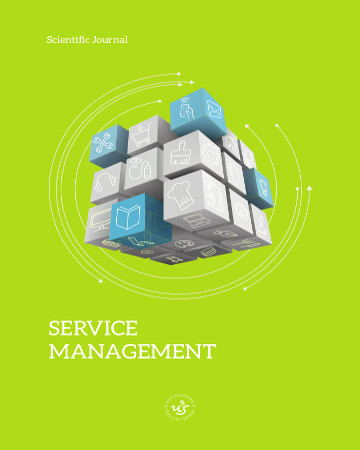
ISSN: 2450-8535
eISSN: 2353-2858
OAI
DOI: 10.18276/ejsm.2017.21-06


Issue archive /
Vol. 21, 1/2017
Circular economy and new ways of doing business in the tourism sector
| Authors: |
Giulio
Pattanaro
Independent Reseacher Vincenzo Gente Independent Reseacher, Italy |
| Keywords: | circular economy tourism development business models sustainability |
| Data publikacji całości: | 2017 |
| Page range: | 6 (45-50) |
| Klasyfikacja JEL: | Q30 Q53 Q56 Z32 |
Abstract
In alternative to the current linear economic model of extraction use and disposal, the emerging concept of circular economy stresses the importance of maintaining the value of products, materials and resources inside the economy thus reducing waste generation and improving sustainability. The opportunity of switching to a circular model of production and consumption is currently explored in different economic sectors, including tourism.
This paper investigates the transition towards circular economy in the area of tourism. After a review of the most relevant literature on the subject, some concrete examples of circular economy applied to tourism destinations and companies are examined and compared. The implications of the transition towards circular economy in the area of tourism, mainly in terms of new business models and practices, are then analysed and discussed. Further research on the topic and the investigation of additional case studies is finally suggested.
Key words: circular economy, tourism development, business models, sustainability
Download file
Article file
Bibliography
| 1. | Basu, R. (2001). New criteria of performance management. Measuring Business Excellence, 5(4), 7-1. |
| 2. | Cusumano, M. A. (2015). How Traditional Firms Must Compete in the Sharing Economy. Communications of the ACM, 58(1), 32-34. |
| 3. | Ellen MacArthur Foundation (2015). Delivering the Circular Economy a Toolkit for Policymakers. Cowes: Ellen MacArthur Foundation. |
| 4. | European Commission (EC) (2015). Closing the loop – An EU action plan for the Circular Economy, COM (2015) 614. |
| 5. | Fan, Y. (2008). Research on the Development of Tourism Circular Economy in Henan Province. Proceedings of International Conference on Industry Cluster Development and Management, 550-553. |
| 6. | Geng, Y., Zhu, Q., Doberstein, B., & Fujita, T. (2009). Implementing China’s circular economy concept at the regional level: A review of progress in Dalian, China. Waste Management, 29, 996-1002. |
| 7. | Genovese, A., Acquaye, A. A., Figueroa, A., & Koh, S. L. (2017). Sustainable supply chain management and the transition towards a circular economy: Evidence and some applications. Omega, 26, 344-357 |
| 8. | Gunther, M. (2014). Disney World’s biogas facility: a model for converting food waste into energy. The Guardian sustainable business, 17 October. Available: http://the.guardian.com (July 27, 2016). |
| 9. | Hamari, J., Sjöklint, M., & Ukkonen, A. (2015). The sharing economy: Why people participate in collaborative consumption. Journal of the Association for Information Science and Technology, 1-13. |
| 10. | Kenney, M. and Zysman, J. (2015). Choosing a future in the platform economy: the implications and consequences of digital platforms. Kauffman Foundation New Entrepreneurial Growth Conference – Discussion papers. Available: http://www.brie.berkeley.edu (July 20, 2016). |
| 11. | Lazy, P. (2015). The Circular Economy. Great idea but can it work? Forbes, 20 January. Available: http://www.forbes.com (July 28, 2016). |
| 12. | Lewandowski, M. (2016). Designing the Business Models for Circular Economy – Towards the Conceptual Framework. Sustainability, 8(1), 1-28. |
| 13. | Lieder, M., & Rashid, A. (2016). Towards circular economy implementation: a comprehensive review in context of manufacturing industry. Journal of Cleaner Production, 115, 36-51. |
| 14. | Organisation for Economic Co-operation and Development (OECD) (2015). Material Resources, Productivity and the Environment. Paris: OECD Publishing. |
| 15. | Osterwalder, A., & Pigneur, Y. (2010). Business model generation: a handbook for visionaries, game changers, and challengers. Hoboken: John Wiley & Sons. |
| 16. | Strazza, C., Magrassi, F., Gallo, M., & Del Borghi, A. (2015). Life Cycle Assessment from food to food: A case study of circular economy from cruise ships to aquaculture. Sustainable Production and Consumption, 2, 40-51. |
| 17. | Su, B., Heshmati, A., Geng, Y., & Yu, X. (2013). A review of the circular economy in China: moving from rethoric to implementation. Journal of Cleaner Production, 42, 215-227. |
| 18. | Tang, Z. (2015). An integrated approach to evaluating the coupling coordination between tourism and the environment. Tourism Management, 46, 11-19. |
| 19. | The Guardian (2016). Circular Economy Hub. Available: http://the.guardian.com (November 1, 2016). |
| 20. | The Netherlands Circular Hotspot (TNCH) (2016). The Netherlands Circular Hotspot. Available: http://www.netherlandscircularhotspot.nl (October 30, 2016). |
| 21. | VenloGreenPark (2016). Greenport Venlo. Available: http://www.venlogreenpark.nl (November 1, 2016). |
| 22. | World Commission on Environment and Development (WCED) (1987). Our Common Future. Available: http://www.un-documents.net (October 30, 2016) |
| 23. | World Economic Forum (WEF) (2014). Towards the Circular Economy: Accelerating the scale-up across global supply chains. Geneva: WEF. |
| 24. | Wu, L. Dong, S., & Chen, F. (2010). A study on tourism development model with dynamic mechanism of circular economy. Ecological Economy, 6, 439-446. |
| 25. | Zhang, X., & Xiao, C. (2015). Research on the Tourism Circular Economy Mode – Mt.Emei Scenic Area. International Journal of Managerial Studies and Research, 3(6), 91-96. |